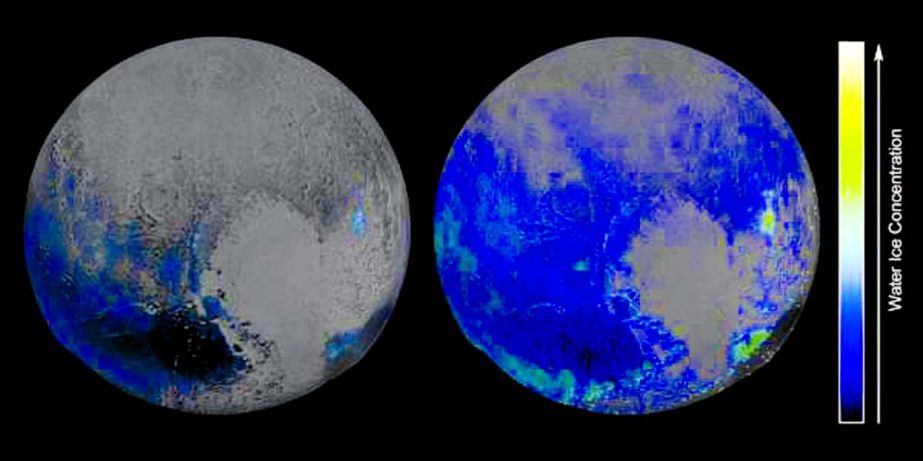
Lights In The Dark :
When New Horizons made its close pass pf Pluto on July 14, 2015, it did much more than just take pretty pictures; it was also scanning the planet with a suite of science instruments designed to determine the nature of its surface, atmosphere, composition, and other key characteristics. One of these instruments was the Linear Etalon Imaging Spectral Array (LEISA), an infrared scanner that can detect the unique molecular “fingerprints” of particular elements and compounds like methane, nitrogen, carbon monoxide… and water (one of our favorites!)
At first the data returned from LEISA showed only a surprisingly small amount of water ice across Pluto’s surface. But that was water ice in its pure form; when researchers took into consideration ice containing a mixture of water and other materials they found a much more widespread distribution across the surface area visible to New Horizons.
A disadvantage of that technique is that water
ice’s spectral signature is easily masked by methane ice, so that map was only sensitive to areas that were especially rich in water ice and/or depleted in methane. The much more sensitive method used on the right involves modeling the contributions of Pluto’s various ices all together. This method, too, has limitations in that it can only map ices included in the model, but the team is continually adding more data and improving the model.
While the new models greatly expand the area that water ice – which is basically bedrock on the -380-degree-F Pluto – exists, they do continue to show a marked lack of water across the heart-shaped Sputnik Planum and into the northern polar areas (which are technically south, but that’s another story.) Those regions are coated with other materials – namely, nitrogen and methane ices that have either been deposited from the atmosphere or oozed up from below Pluto’s crust.
Even now, over six months after New Horizons’ historic visit, Pluto is giving us plenty of surprises! (And will likely continue to do so for a long time!)
When New Horizons made its close pass pf Pluto on July 14, 2015, it did much more than just take pretty pictures; it was also scanning the planet with a suite of science instruments designed to determine the nature of its surface, atmosphere, composition, and other key characteristics. One of these instruments was the Linear Etalon Imaging Spectral Array (LEISA), an infrared scanner that can detect the unique molecular “fingerprints” of particular elements and compounds like methane, nitrogen, carbon monoxide… and water (one of our favorites!)
At first the data returned from LEISA showed only a surprisingly small amount of water ice across Pluto’s surface. But that was water ice in its pure form; when researchers took into consideration ice containing a mixture of water and other materials they found a much more widespread distribution across the surface area visible to New Horizons.
A disadvantage of that technique is that water
ice’s spectral signature is easily masked by methane ice, so that map was only sensitive to areas that were especially rich in water ice and/or depleted in methane. The much more sensitive method used on the right involves modeling the contributions of Pluto’s various ices all together. This method, too, has limitations in that it can only map ices included in the model, but the team is continually adding more data and improving the model.
While the new models greatly expand the area that water ice – which is basically bedrock on the -380-degree-F Pluto – exists, they do continue to show a marked lack of water across the heart-shaped Sputnik Planum and into the northern polar areas (which are technically south, but that’s another story.) Those regions are coated with other materials – namely, nitrogen and methane ices that have either been deposited from the atmosphere or oozed up from below Pluto’s crust.
Even now, over six months after New Horizons’ historic visit, Pluto is giving us plenty of surprises! (And will likely continue to do so for a long time!)

